Introduction
When I had to find a replacement for the installation of the Arch based Condres OS on my Acer V15 Nitro Black Edition -- which I use for media consumption -- because Condres OS suddenly discontinued development, I decided to find another Arch based distribution to replace Condres. I settled on ArcoLinux which is developed by the creator of the excellent Sardi icons. In recent months, ArcoLinux has been rising steadily in the Distrowatch rankings and is currently ranked 15th in the 6 months list.
As ArcoLinux describes itself, it:
is a distribution based on Arch Linux. ArcoLinux installs with a graphical installer with ease and comfort. There are 3 major projects. ArcoLinux is a full featured iso containing a ton of software and 3 desktops Xfce, Openbox and i3. ArcoLinuxD is a minimal iso dropping you in the command line. With scripts you install any desktop and application you want. ArcoLinuxB will give the user the power to actually build his own iso. The user decides what desktop and applications go on the iso. ArcoLinux features hundreds of video tutorials on 5 websites and places a strong focus on learning and has even a learning plan. ArcoLinux promotes the use of Arch Linux on which it is based. There are 13 desktops and 29 iso’s to choose from. Awesome, Bspwm, Budgie, Cinnamon, Deepin, Gnome, i3, Mate, Openbox, Plasma, Qtile, Xfce, Xmonad, …
The base for ArcoLinux's learning plan is the ArcoLinux websites -- there are actually two main sites, arcolinux.com and arcolinux.info, which link to other sites for each variant. The websites feature lots of embedded videos on one page, many describing and depicting the websites themselves, and others offering practical tutorials on assembling Arch Linux the ArcoLinux way. I found the websites to be confusing and disorganized, with the flow of pages on the websites unclear. Maybe a WordPress site is not the best platform for the type of site(s) it aims to be.
I eventually learned that the focus of the ArcoLinux project is to provide users a path for learning Linux through a six phase program.
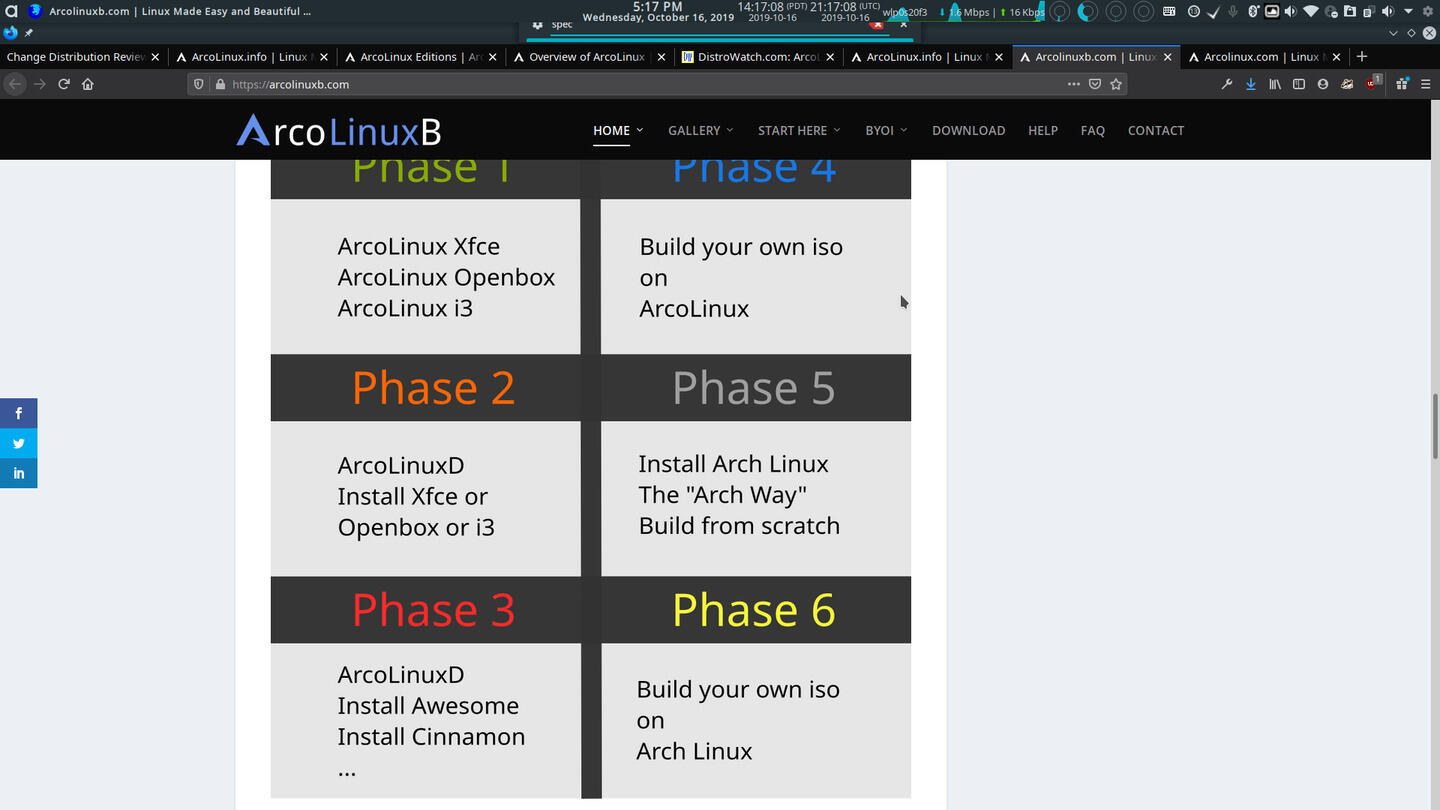
The Six Phase ArcoLinux Linux Education Plan
This is a rigid plan that seems to emphasize tiling and lightweight environments, at least initially.
Each of the three variants of ArcoLinux -- ArcoLinux, ArcoLinuxB, and ArcoLinuxD -- plays a role in one or more of these phases. In Phase I users install ArcoLinux from a full ISO that results in a system with complete and fully customized Openbox, i3, and Xfce environments out-of-the-box. In Phase II users use the ArcoLinuxD ISO to install an Xfce, Openbox, or i3 based system, from a terminal based environment. It is unclear from the website (I didn't want to wade through the countless introductory videos that only show the website itself to eventually stumble upon a video that clarifies things) whether the ISO installs a minimal Arch system that users build upon using ArcoLinux scripts, or if the ArcoLinux scripts are run from a live environment itself. In Phase III ArcoLinuxD is used similarly to Phase II, but users install any desktop environment of their choice, instead of those prescribed by Phase II of the plan. In Phase IV users utilize ArcoLinuxB, an environment I assume is similar to the live ISO environment shown in screenshots in ArcoLinuxB 19.07.9 Review [Plasma Edition] Supplement: Installation to build a customized installation ISO using arch-iso. In Phase V, users install Arch by following the Arch Wiki through the first reboot, then use ArcoLinux videos to install the rest of the components to complete the Arch system. In Phase VI, users build a customized ISO using arch-iso from Arch itself.
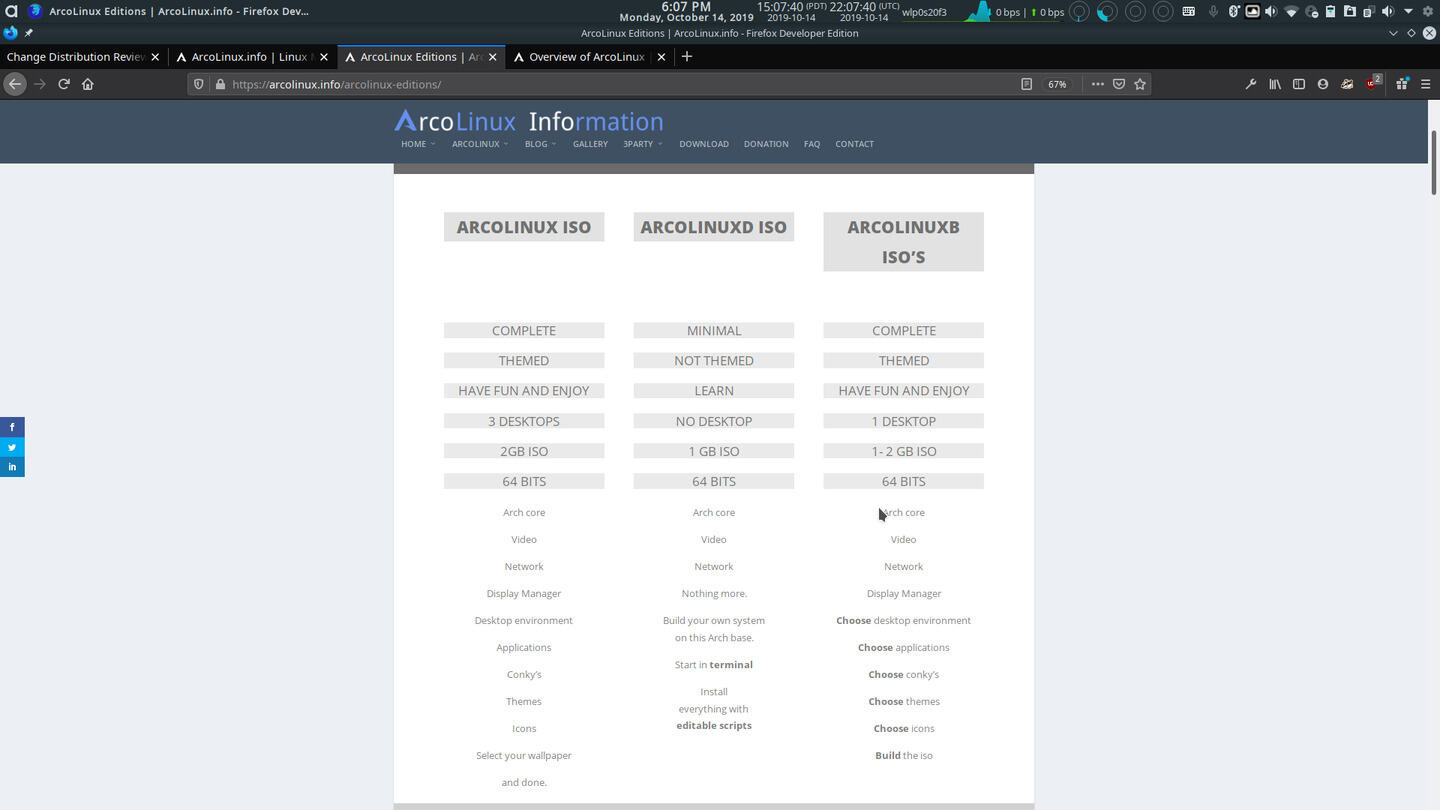
The ArcoLinux Variants Are Used in Particular Phases
The main edition simply named ArcoLinux is the only edition that provides a fully configured and customized environment, installing i3, Openbox, and Xfce. ArcoLinuxB and ArcoLinuxD, besides community prepared ISOs of ArcoLinuxB, require users to install and configure everything beyond a core Arch Linux system.
My goals for installing ArcoLinux, which I mentioned above, didn't require following the ArcoLinux education plan, so I installed ArcoLinux on my Acer V15 Nitro from a community prepared ISO of ArcoLinuxB Plasma Edition. I liked the Arco customizations available in the installed system so much, I decided to use the ISO to install ArcoLinux on my Dell G5 5587.
The Default State of the Plasma Desktop on ArcoLinuxB Plasma Community Edition
While there are customizations available in the installation they are not applied by default.
Unfortunately, unlike the installation of ArcoLinuxB on the Acer, the installation on the Dell resulted in the system freezing at the login screen. I discuss the installation on the Acer, the cause of the problem on the Dell, and the solution in ArcoLinuxB 19.07.9 Review [Plasma Edition] Supplement: Installation.
Review
My immediate favorable impressions of ArcoLinux were due to the customizations included in this community build of ArcoLinuxB. While not activated by default, customizations included many Plasma Look and Feel themes (called Global Theme beginning with Plasma 5.17) -- including all of the separate components that make up the overall Look and Feel theme such as window decorations, Plasmashell theme, and color schemes. These themes are KDE versions of popular GTK themes allowing for a uniformity between GTK and KDE apps.
After Some Incremental Application of Included Themes
Theme elements provided by default include all of the Sardi and Surfn icon variants created by the ArcoLinux developer, as well as some Numix, Zafiro, and Halo icons.
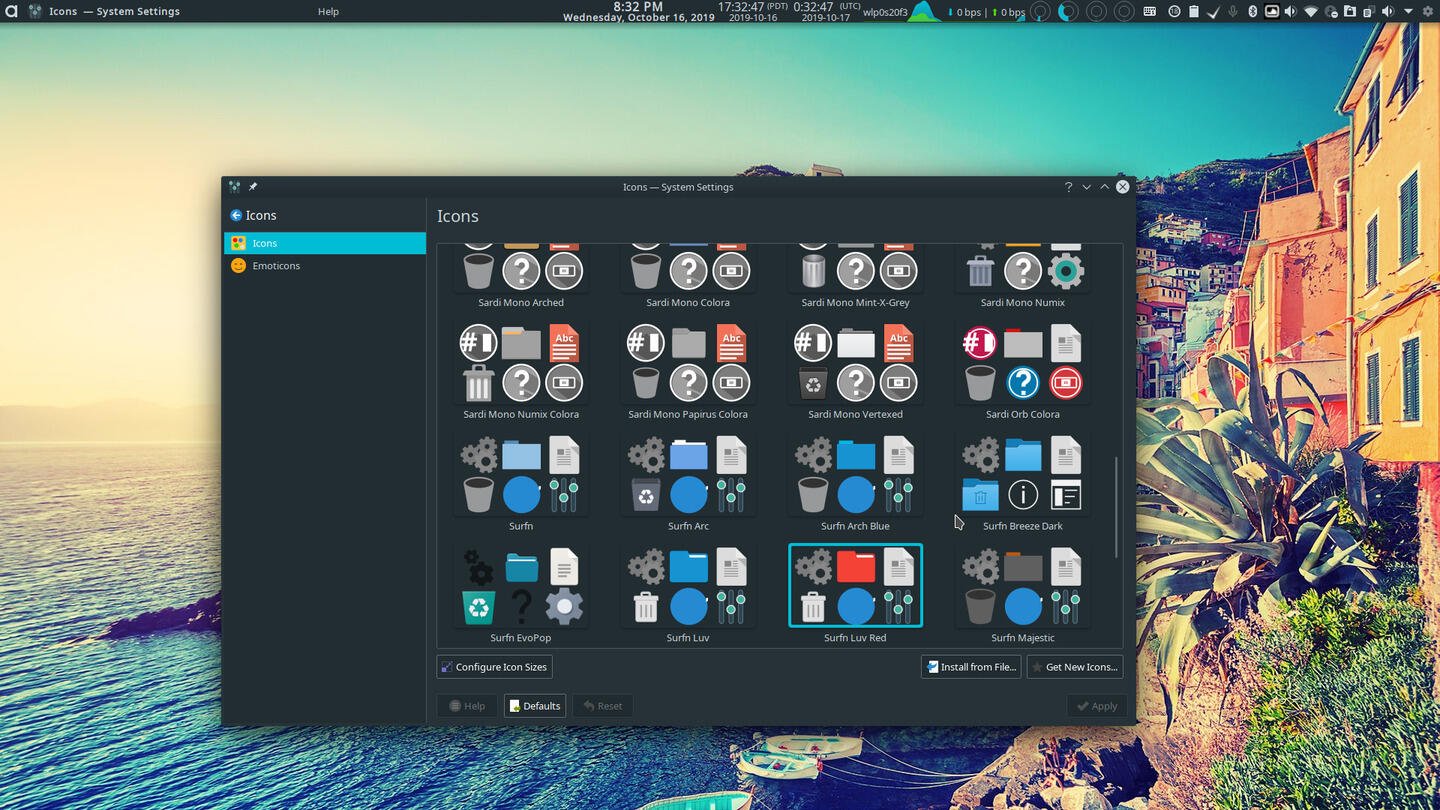
ArcoLinux Provides the Sardi and Surfin Icons Also Created by the ArcoLinux Developer
The Variety wallpaper changer is also included with numerous unique wallpapers and the beautiful one featured in the hero image at the top of this article, in the image above, and the image below.
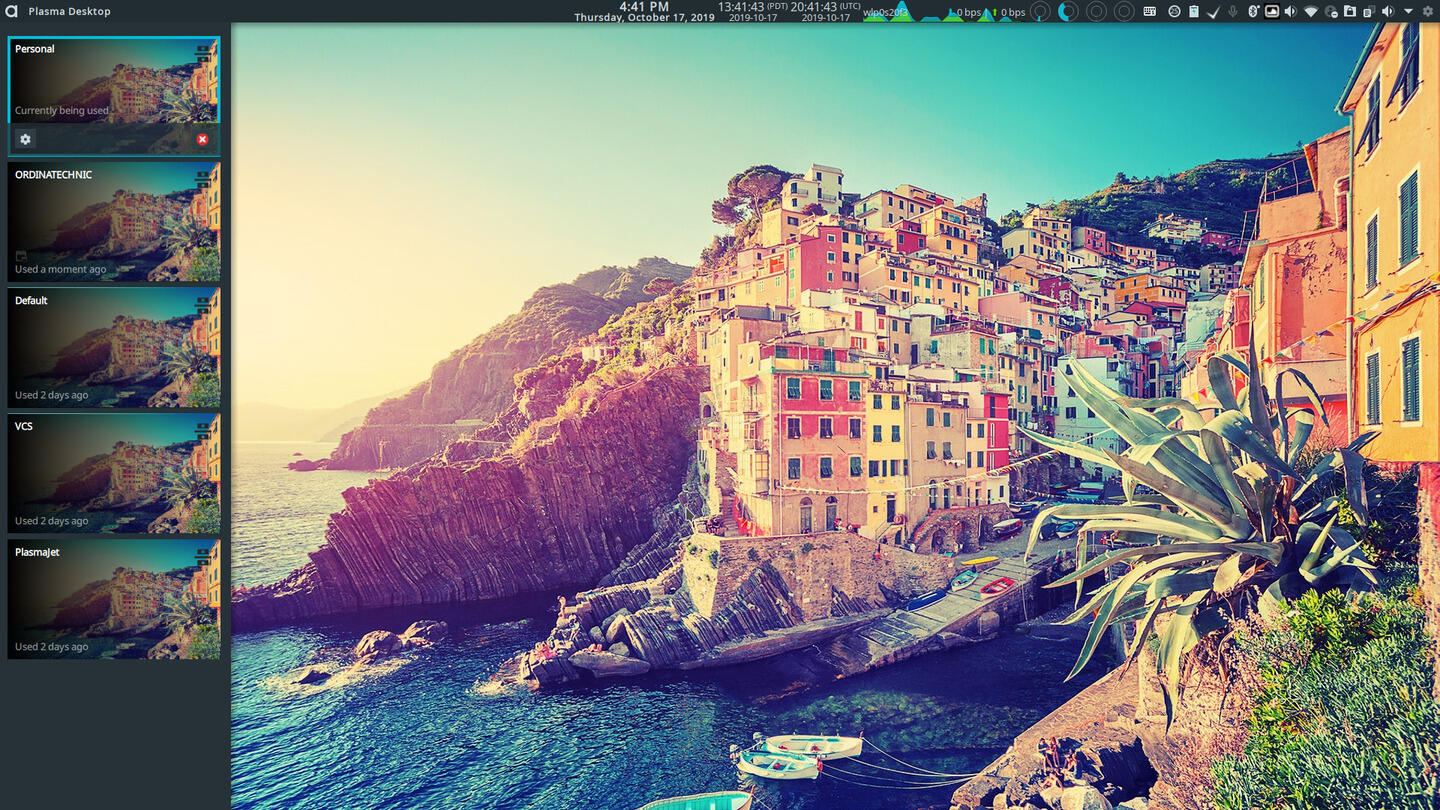
Displaying different wallpapers on Each Activity (not desktop) Seems to Not Be Possible with Variety
Unfortunately, Variety may not be appropriate for Plasma users who take advantage of Plasma's Activities feature. I like to have different wallpapers for each activity (not desktop) as an additional way to distinguish activities, but Variety interferes with this.
Other customizations available in the installation:
- Kwin settings are not default, with four desktops enabled and window minimize/maximize/snap animations modified, as well as wobbly windows activated
- There are many Conkies available, although ArcoLinux is in need of a Conky manager, at least in this particular edition, similar to what the Voyager distribution provides.
- There are numerous additional fonts than what might usually be found in a typical Linux distribution, mostly for use by the Conkies
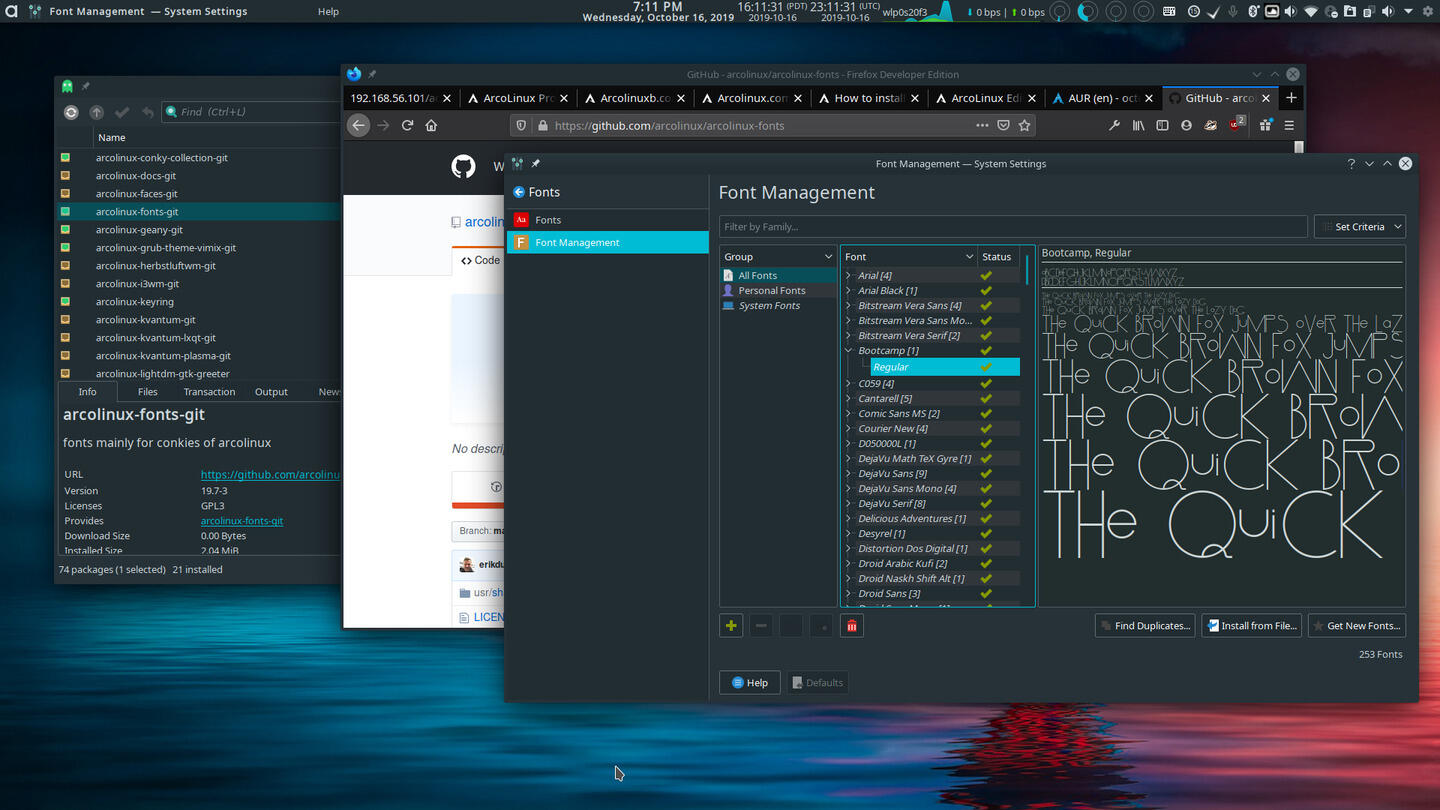
One of the Additional Fonts Available on ArcoLinuxB Community Edition Plasma Version
Beyond those customizations related to the visual appeal to the user, there were many practical customizations. These included the addition of many aliases to .bashrc to save a couple of seconds off some package management commands or to save users from having to memorize options. Some of which I thought were more useful and that I liked were aliases to several reflector and youtube-dl command/option combinations, which I further customized as is encouraged by the developer. I don't usually use configure aliases in .bashrc -- the only changes I make to .bashrc are the addition of a few lines to activate Liquidprompt, but since these are here I will use them.
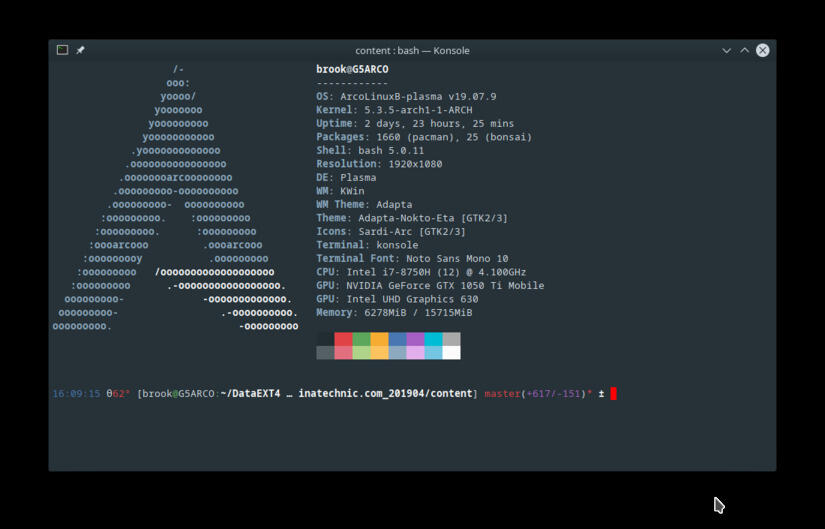
Konsole Displaying the ArcoLinux Neofetch Information and a Custom Prompt Provided by Liquidprompt
Neofetch is Executed by the Custom ArcoLinux .bashrc. Liquidprompt, besides improving the appearance of the shell prompt, provides some useful information, including those related to git.
Even more useful is the inclusion of the AUR helpers, trizen and yay, saving users from the involved process of obtaining packages from the AUR on an Arch Linux system that is configured without the unofficial helpers. The community version of the distribution also provides the GUI front end to pamac for GUI package management, although the AUR isn't enabled by default in this program. I found the default installation of the pamac GUI to be unusual as it is GTK based and I installed the Plasma edition of an ArcoLinuxB community build. I would think that Octopi would be more appropriate as it is Qt based and has integrations into Plasma -- and is just as functional as Pamac. I installed it using yay.
Not only did I have to install it, but I had to install it from the AUR and not the ArcoLinux repositories. This package is distributed by the AUR in the typical way, requiring users to obtain the PKGBUILD from the AUR, compile the source, create a binary package, and install the binary package -- although this process is automated by the provided AUR helper. It is not distributed as a prebuilt binary package as some packages are distributed from the AUR. This touches upon one difference between ArcoLinux and many other Arch based distributions, in that the others usually provide prebuilt binary packages of many popular AUR packages from their own repositories.
The ArcoLinux Repositories and Their Contents Displayed in Octopi
Antergos and Condres OS -- to an even larger extent -- did this, as does Manjaro, as a convenience for users. ArcoLinux only provides a few of these packages from their own repositories, including Spotify, Sublime Text Editor, Dropbox, and yay.
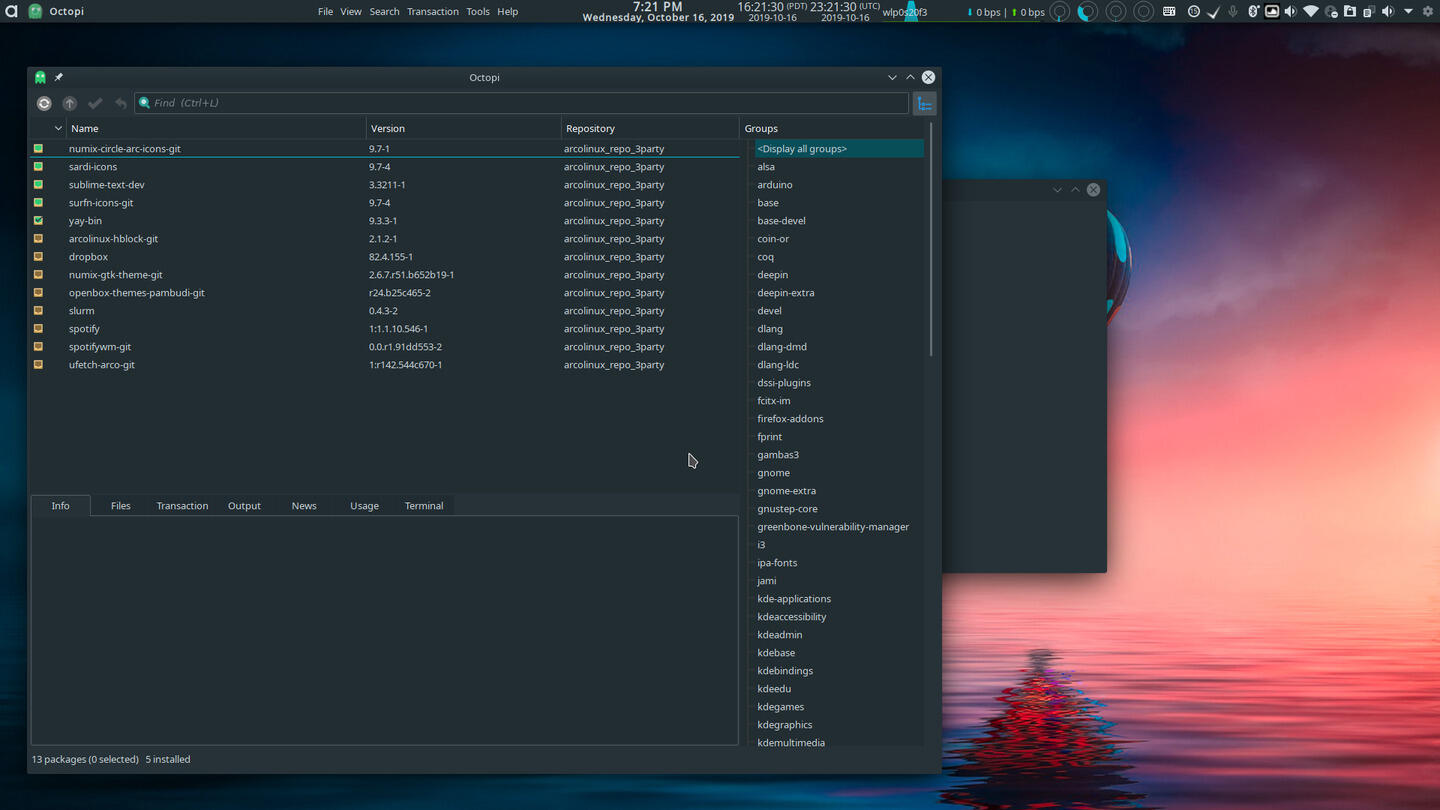
Octopi Displaying Packages in the ArcoLinux Third-Party Repository
The selection of prebuilt binaries of third-party packages is not as extensive as other Arch based distributions.
It also relies too heavily on the AUR -- increasing system instability, needlessly lengthening upgrade operations, and expending system resources -- using AUR versions of packages that possibly could be sourced from Arch or prebuilt by the distribution from more stable upstream releases.
Other items also seemed out of place besides Pamac in a Plasma based installation, including the use of LightDM as the display manager with a GTK greeter theme instead of SDDM display manager, with either the default Breeze greeter theme, or preferably, the easily customizable Sugar Candy greeter theme. A git version of Thunar (why not a more stable version from the Arch repos), the Xfce environment's package manager is installed, although this may be an oversight related to the live environment, and not a choice by the distribution.
These failings, if they are even that, may be attributed to the distribution's focus on providing users with a learning experience and demonstrating what is possible, and not really on providing users with a convenient Arch installation and subsequent maintenance by developers and the distribution's infrastructure. (Many Arch based distributions provide the former, only Manjaro provides the latter as well).
But this brings to light two considerations with ArcoLinux -- the learning plan is overly rigid and not straightforward enough, with countless videos that show only the project's websites, and that it may not be enough to prepare users to solve problems, emphasizing only customizing lightweight desktop environments.
If the point is to learn Linux through assembling an Arch system, it might be better to learn it through the excellent and straightforward guidance of the Arch documentation. In fact, one of the phases of the Arco Linux plan is to follow the Arch wiki for the base install, and then to follow the Arco videos for everything related to the display and beyond. Arco instead wants users to follow a rigid learning path that in large part emphasizes desktop environments that users may not be interested in. The ArcoLinux learning plan culminates in learning to use arch-iso, which at its heart just requires users to specify a standard base Arch configuration and to list packages in a file to be installed by used by arch-iso to build the custom ISO.
Consider that the installation of ArcoLinuxB using an ISO produced in this way by the community, while successful on my Acer, resulted in a non-functioning system on my Dell. Maybe this could be avoided if the ArcoLinux implementation of Calamares included better hardware detection in its back-end, preventing the installation of irrelevant drivers of AMD and ATI drivers on a system that doesn't include AMD or ATI hardware. If the community developed ISO produced in this way, using the same method ArcoLinux teaches, resulted in a non-functioning installation, while an installation using the Arch documentation resulted in a perfectly working Arch system, maybe something is missing in the ArcoLinux education plan.
I was able to fix the issue on the Dell, thanks to my past education following the Arch installation instructions, while a frustrated ArcoLinux user who posted a similar problem on an ArcoLinux forum thread indicated that they would return to their previous distribution -- Manjaro -- when confronted with a similar issue, and couldn't get a solution on the ArcoLinux forum.
Recommendation
I do recommend the ArcoLinuxB Community Editions, especially for users who have experience with Arch and the Arch documentation, and for some reason want to install an Arch system -- that uses the Arch repositories and Arch kernel -- easily. In my case I had Arch installed the Arch way -- although using the shortcut of installing from an existing Linux via chroot -- and wanted to install Arch easily on a second system, then on another partition of the first system.
I installed it on two computers one after the other because I liked the Plasma version so much on my secondary laptop, that I quickly wanted to install it on my primary laptop. On my Acer it provided me a quick installation of a fully working Arch system with many conveniences. Unfortunately, on my Dell it resulted in a system that would freeze at the login screen, which I fixed quickly by chrooting into the ArcoLinux installation from my Arch installation and removing problematic drivers and installing more appropriate ones. (You can read about this process in ArcoLinuxB 19.07.9 Review [Plasma Edition] Supplement: Installation
But I do have some reservations on the overall project. Re-reading the description of the six-phase learning plan in the Introduction, above, I found the process confusing. It seems to eschew the KISS philosophy of Arch in its method. Perhaps two branches would be better, one for learning that guides users through the process of assembling an Arch system from a minimal terminal based system with videos following the complete steps of installing an Arch system based on the Arch Wiki, and another branch that offers fully customized and preconfigured environments like the community editions.
But it is great that potential users and learners have ArcoLinux as an alternative in how they learn Linux and Arch, although I don't think it is as good as learning Arch by installing following the more direct Arch documentation. ArcoLinux itself in Phase V of the education plan has users install Arch by following the Arch documentation, but unfortunately, only to the point the core system is installed, then by following Arco videos. Following the Arch documentation beyond this point forces users to get to know their computers' hardware and install appropriate drivers. Installing Arch Linux this way helped me solve the problem on the Dell caused by the selection of inappropriate drivers on the ISO. Maybe not following the Arch wiki all the way in Phase V of the plan deprives users of needed knowledge -- which seems to be the case for the aforementioned ArcoLinux forum user -- which I got from the Arch wiki that helped me resolve the issue on the Dell.
Installation
For more on the live environment, screenshots of the installation process on the Acer, and how I fixed the non-functional installation on the Dell, see ArcoLinuxB 19.07.9 Review [Plasma Edition] Supplement: Installation.
Software
The KDE Plasma Community Edition of ArcoLinuxB provides a huge set of KDE software out-of-the-box as well as a few GTK apps that some consider as superior to their Qt counterparts or are considered the standard for their function, such as Gparted. It makes some atypical choices in the default set, such as providing the highly customizable, but not as privacy focused, Vivaldi web browser selected set as the environment's default browser, although Firefox is included also. This community edition of ArcoLinuxB also doesn't install LibreOffice or any other office suite by default, unlike nearly all other distributions.
Software Installed by ArcoLinuxB Community Plasma Edition 19.07.9
There is a lot of software installed by default, but an office suite is not among them. Note that I installed Firefox Beta from the Mozilla preview distribution channel, and Firefox Developer Edition, TexMaker, TexStudio, Kile, and LyX from the repos. It is u
Click on any of the thumbnails to view a slideshow of the images.
Package Management
Being an Arch based distribution, ArcoLinux uses Arch's pacman package manager.
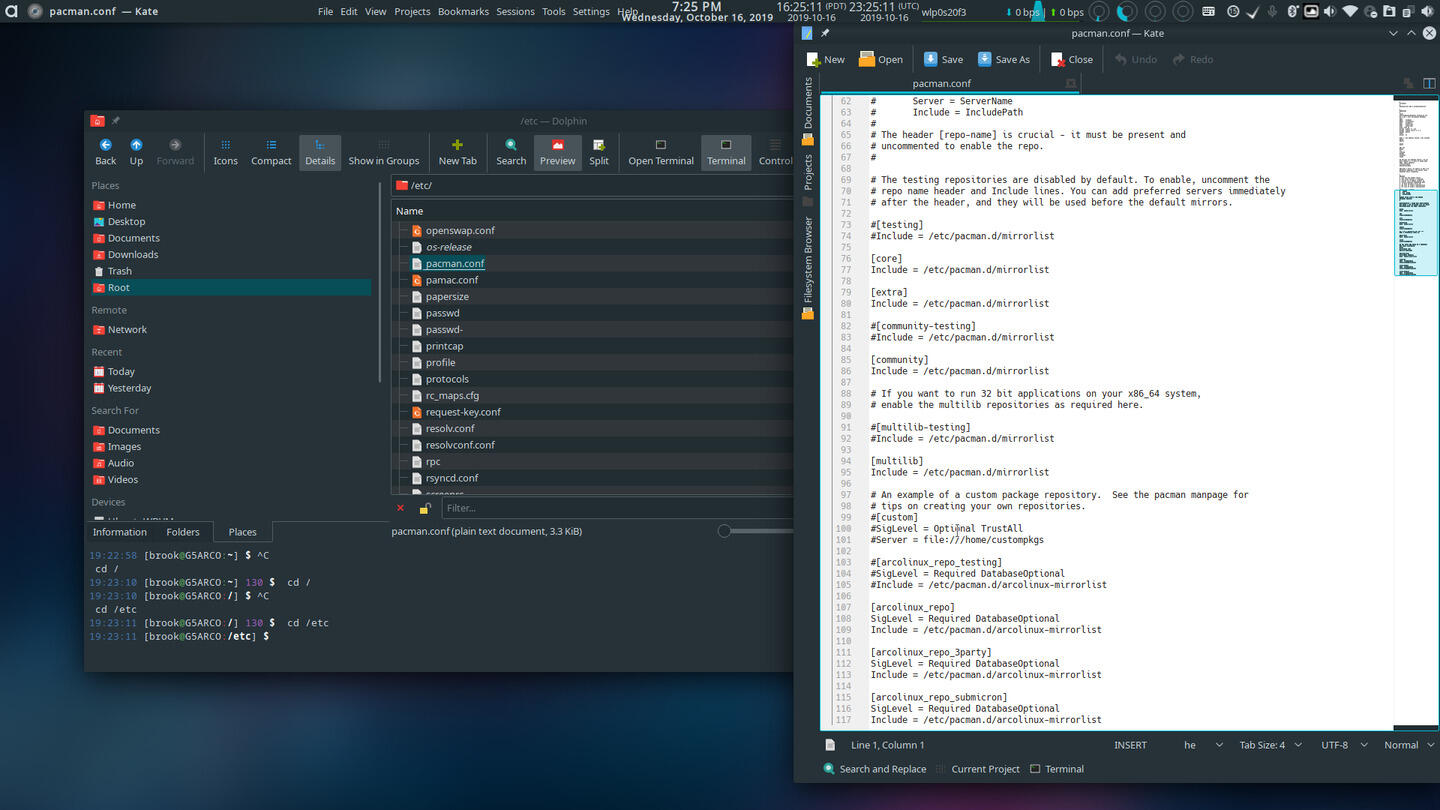
ArcoLinux's Version of the pacman Configuration File /etc/pacman.conf.
ArcoLinux adds three of its own repositories in order to mainly distribute its scripts. Some of the default configuration is modified to make pacman output more convenient and informative. It also enables "Pacman" eating "Power Pills" as the progress indicator in pacman output.
But it eases package management by providing alternative CLI and GUI front ends to libalpm, the core of pacman. It also provides AUR helpers such as trizen and yay although AUR support is not enabled in the Pamac GUI.
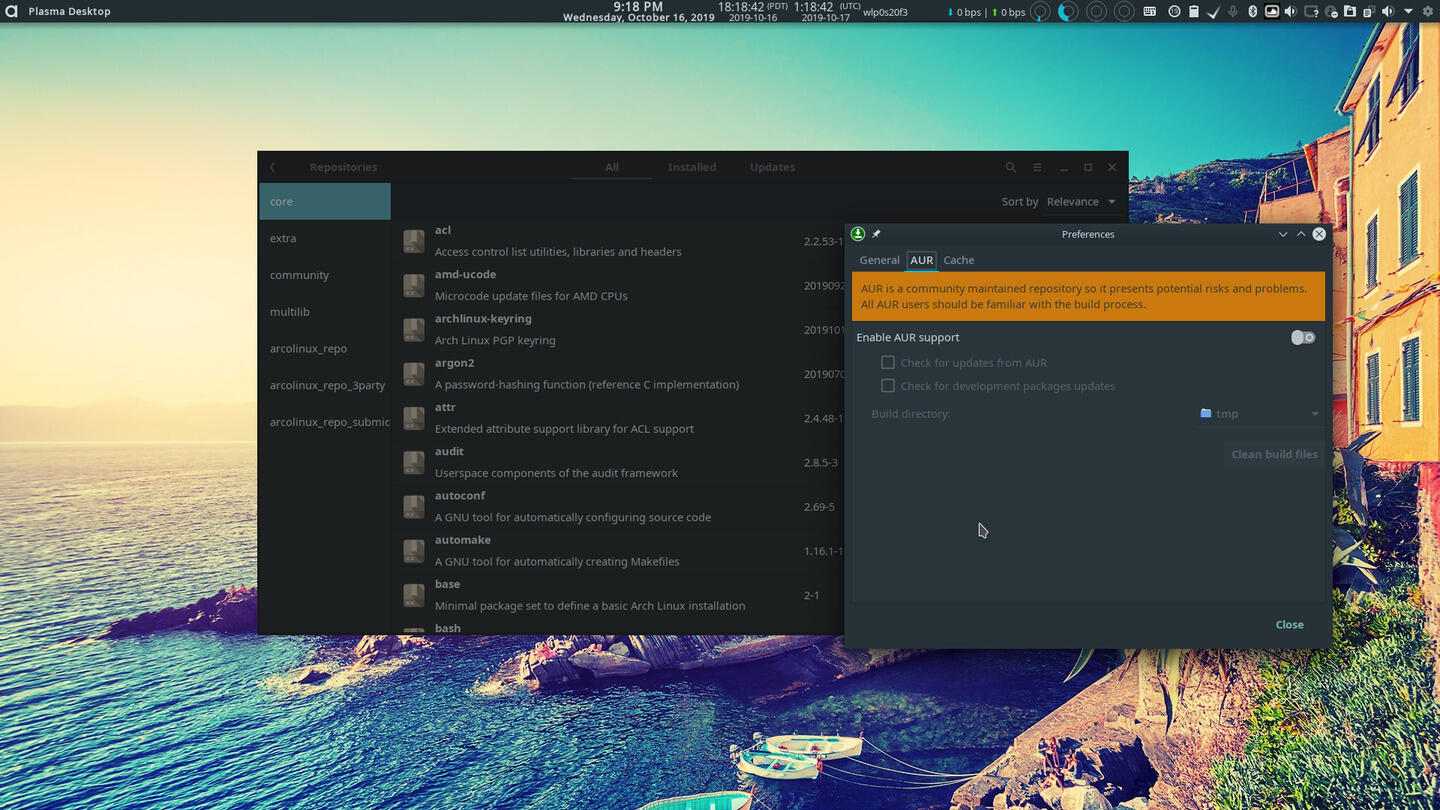
Pamac, a GTK Based GUI Package Management Program Is Included, but Octopi, a Qt Based Tool Is Not
Octopi can be installed from the AUR using the included AUR helper yay>.
Click on any of the thumbnails to view a slideshow of the images.
Fixes and Enhancements
Besides the graphics problem on the Dell, described below and elsewhere in this article, there was only one issue requiring a fix. This was missing language packs for the installed spell checking programs. The spell checking feature of Kate was non-functional, immediately closing when opened. Only one language with a non-Latin based alphabet was displayed in the language selection box of Kate's spell checker. The following command, shown with its output, partly solved the problem allowing the display of different English versions in the language selection boxes. Unfortunately, spelling suggestions still don't work but I'm on the next distribution in my rotation of Linux installations and won't be fixing this issue for now.
23:29:12 [brook@G5ARCO:~] $ sudo pacman -S aspell-en hunspell-en_US
resolving dependencies...
looking for conflicting packages...
Package (2) New Version Net Change Download Size
extra/aspell-en 2018.04.16-1 4.07 MiB 1.07 MiB
extra/hunspell-en_US 2018.04.16-6 2.93 MiB 0.54 MiB
Total Download Size: 1.60 MiB
Total Installed Size: 7.00 MiB
:: Proceed with installation? [Y/n]
:: Retrieving packages...
aspell-en-2018.04.16-1-x86_64 1090.9 KiB 645K/s 00:02 [----------------------------------------] 66%
hunspell-en_US-2018.04.16-6-any 1640.6 KiB 537K/s 00:03 [----------------------------------------] 100%
(2/2) checking keys in keyring [----------------------------------------] 100%
(2/2) checking package integrity [----------------------------------------] 100%
(2/2) loading package files [----------------------------------------] 100%
(2/2) checking for file conflicts [----------------------------------------] 100%
:: Processing package changes...
(1/2) installing aspell-en [----------------------------------------] 100%
(2/2) installing hunspell-en_US [----------------------------------------] 100%
Optional dependencies for hunspell-en_US
hunspell: the spell checking libraries and apps [installed]
:: Running post-transaction hooks...
(1/1) Arming ConditionNeedsUpdate...
The more serious problem was that while The ArcoLinuxB Community Plasma Edition installation on the Acer with an older Intel HD 530/GTX-960M graphics didn't have any problems with the drivers installed by the ArcoLinuxB ISO prepared by the community, the installation on the Dell, with a relatively new Intel UHD 630/GTX-1050Ti M graphics, did have a serious problem such that the system froze upon login. I fixed this issue by chrooting into the ArcoLinuxB installation from my Arch installation and removing the problematic xf86-video-nouveau as well as irrelevant packages and installing the same packages I had installed when installing Arch on the Dell, as shown in the table that follows. For details on this process see: ArcoLinuxB 19.07.9 Review [Plasma Edition] Supplement: Installation.
| Package |
Arch |
Arco |
| xorg-server |
X |
X |
| xorg-apps |
X |
X |
| mesa |
X |
X |
| glu |
X |
X |
| lib32-glu |
X |
|
| lib32-mesa |
X |
|
| bumblebee |
X |
|
| primus |
X |
|
| bbswitch |
X |
|
| lib32-virtualgl |
X |
|
| lib32-primus |
X |
|
| nvidia |
X |
|
| libvdpau |
X |
|
| xf86-video-nouveau |
|
X |
| xf86-video-amdgpu |
|
X |
| xf86-video-ati |
|
X |
| xf86-video-fbdev |
|
X |
| xf86-video-openchrome |
|
X |
| xf86-video-vesa |
|
X |
| xf86-video-vmware |
|
X |
| xf86-video-intel |
|
X |
The ArcoLinuxB Community Plasma Edition is pretty complete and fully configured implementation of an Arch system with a Plasma desktop. Many nice extras were included, from a customized .bashrc, several complete and popular themes that have GTK versions for a unified look when using GTK applications. But I needed to make a few changes. First I replaced the LightDM display manager with SDDM using the following commands.
-
First I installed sddm with:
sudo pacman -S sddm
-
I may have installed sddm-kcm with:
sudo pacman -S sddm-kcm
or it was already installed.
-
Then I disabled LightDM with:
sudo systemctl disable lightdm
-
Then I enabled SDDM with:
sudo systemctl enable sddm
-
I then installed Sugar Candy using the Login Screen (SDDM) section of the Startup and Shutdown category of Plasma System Settings
I also installed Liquidprompt shown in one of the images, above.
I only installed Octopi because I thought it was more appropriate than Pamac for a Plasma based installation. I could have lived without it. Some users may prefer to have it.